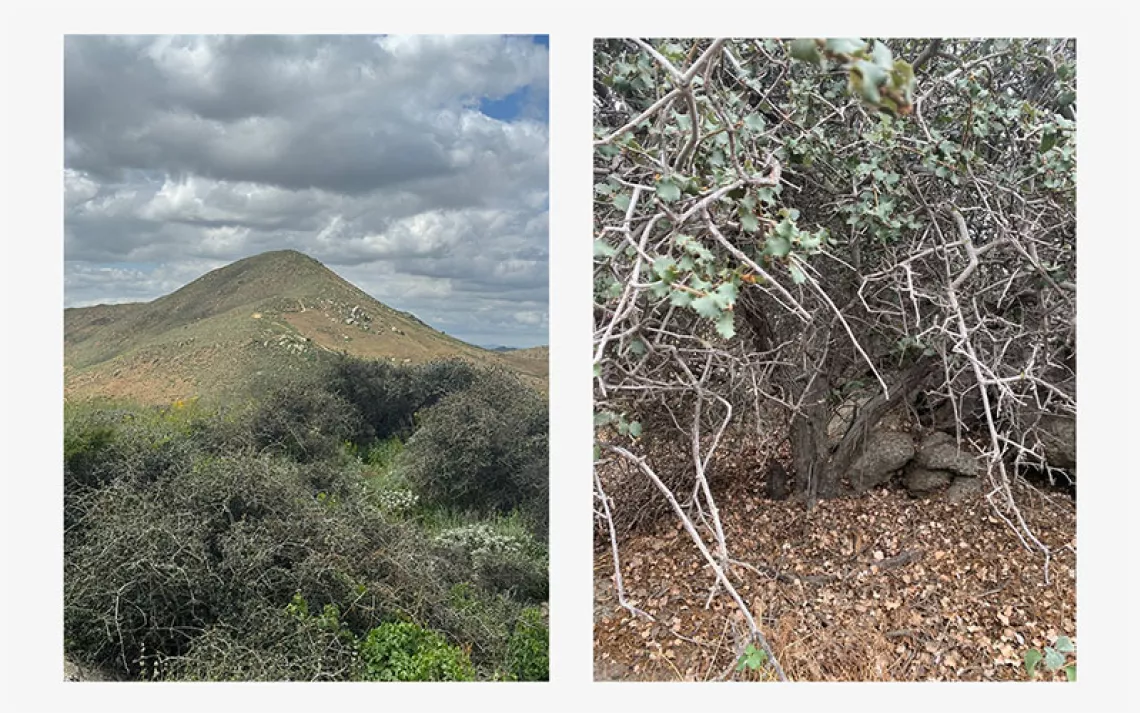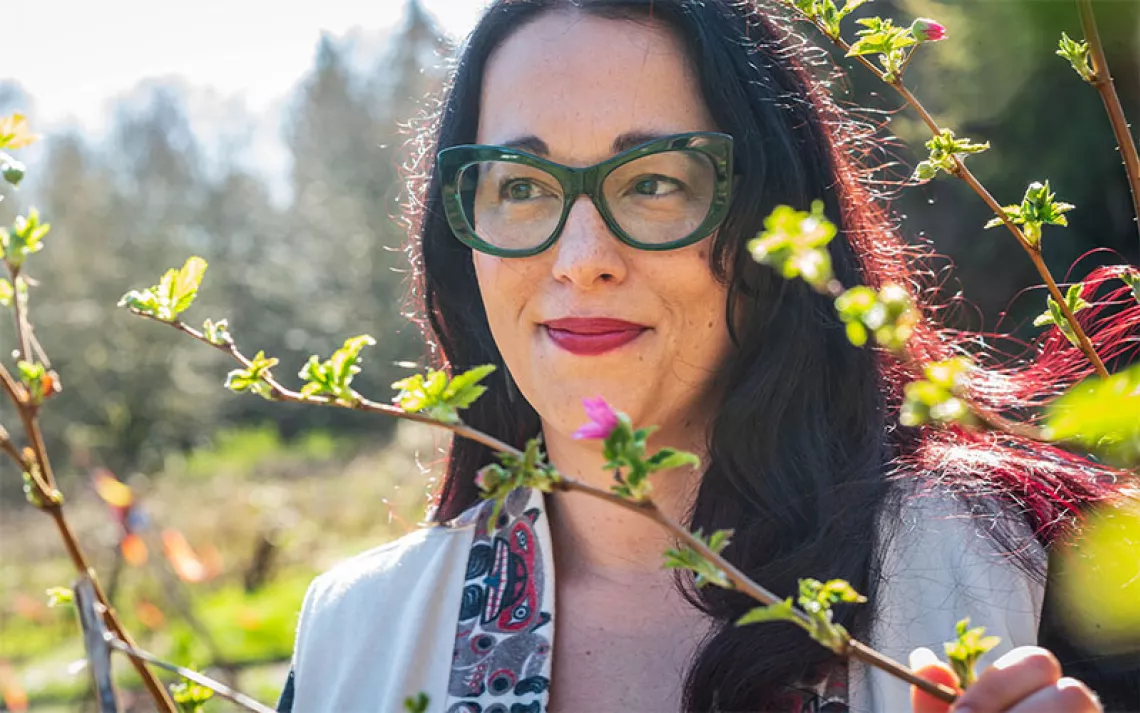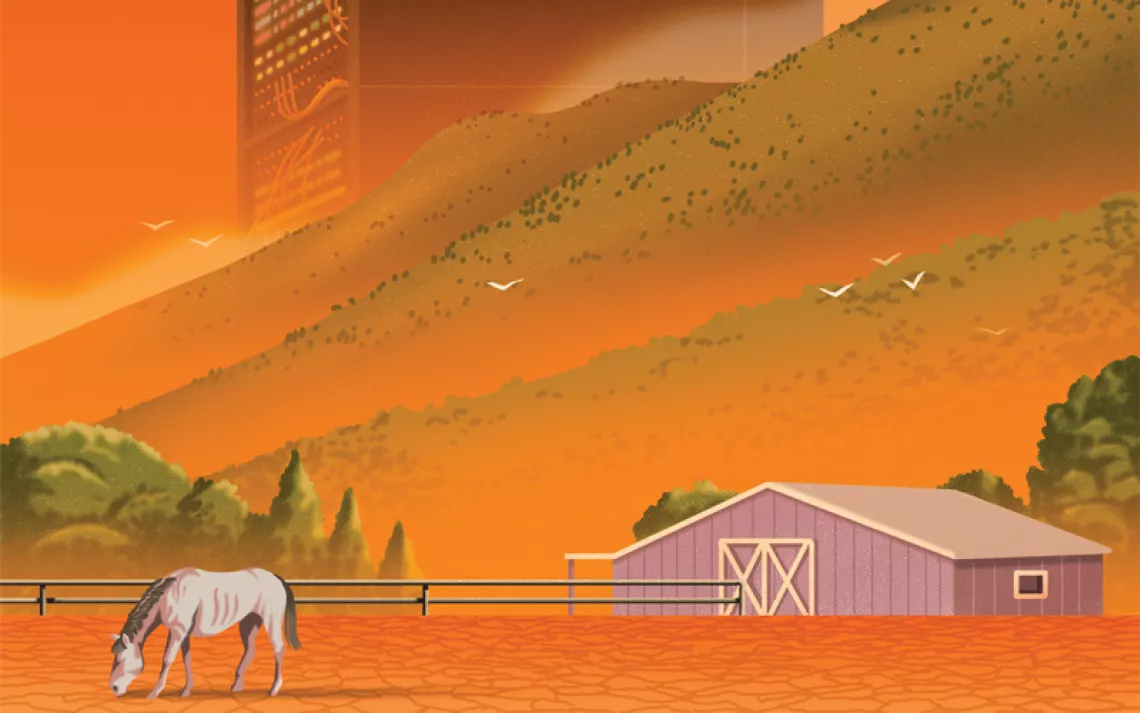Where Glaciers Melt, New Ecosystems Emerge
Finding hope as mountain landscapes adapt to a warming world

Photo by the Mountain Legacy Project
Ash from a nearby fire clung to wisps of my hair as I scrambled under smoke-darkened skies into British Columbia’s Selkirk Range. It was late July 2021. The preceding weeks had brought lightning storms and once-in-a-millennia heat to this Canadian province, igniting hundreds of fires.
But up at 8,000 feet I was cold, hands damp with meltwater from the Avalanche Glacier that covers the eastern flank of Avalanche Mountain. I was there as a researcher with the Mountain Legacy Project, taking landscape photographs we’d later compare with glass plate negatives from the turn of the 19th century. The original photographs were used to draw maps when the region’s borders were still being established. My team would contrast the images to map the boundaries of retreating glaciers, and the new ecosystems arising in their wake.
BC’s interior mountains—the Selkirk, the Purcell, the Monashee, and the Cariboo Ranges—are experiencing some of the most rapid melt of any place on Earth. Some models predict a BC landscape with no glaciers at all as early as the 2080s. I had come to the Selkirks expecting to be overcome by a leaden grief. But with every inch a glacier recedes, new habitat emerges for cold-weather species that will be pushed out of the surrounding valleys as they warm. Instead of grief, I felt buoyed by the new life I saw growing everywhere.
Beneath the Avalanche Glacier’s jagged edge, I stood on red rock where 10 years before there had been ice. Around me were avalanche lilies, leatherleaf saxifrages, broadleaf arnica, and Indian paintbrush in full bloom. These flowers are among the first visible species to arise in the early stages of primary succession, the process by which organisms begin to inhabit a recently exposed patch of land. The flexible spines of pine saplings grew from fissures in the granite. Even the barren slabs were mosaiced by technicolor lichens.
*
Scientists call places like this glacial forefields. When glaciers melt, they leave behind a mess of talus and till, rock and sediment scattered chaotically over slabby bedrock scored by the dragging of the ice. Bacteria on the glacier surface are deposited on the ground as the ice melts. Water pools in low places, then moss grows. Lichens spread. Together, these organisms transform minerals into carbon-rich soil. Some research has shown that lichens can convert bedrock into soil in as little as three years.
And in that soil, plants begin to grow. First come the little, fine-rooted things, like the lilies and saxifrages I saw in the Selkirk Range. But as I trudged up the forefield of the Avalanche Glacier, I also had to pull apart alders with my hands, tunneling through two-decade-old thickets. Alders are a primary “engineer species” in BC’s interior mountains, in some places arriving just five or 10 years after ice disappears. With their strong, woody roots, they stabilize the earth. Within a decade or two, those alders will likely cede to a diverse canopy of cottonwoods, hemlocks, and firs.
For more than a century, ecologists have understood primary succession to be a mostly linear process. Dirt gives way to bacterial, algal, and mycelial networks, then pioneer plants arrive. Decades pass before a landscape stabilizes into its final composition—perhaps a forest, or a grassland. But in post-glacial environments, these time-tested theories falter. When charting a glacier’s melt, one does not find a contour map of successional stages that mirror passing time. Ecological development comes in fits and starts. It is a complex mosaic.
Fascination with this mosaic does not diminish the loss of glaciers. A friend of mine once called glaciers the charismatic megafauna of the landscape. We are understandably obsessed with their disappearance. “We do not know which to fear more,” Craig Santos Perez wrote in his poem “Thirteen Ways of Looking at a Glacier (after Wallace Stevens)”: “The terror of change / Or the terror of uncertainty / The glacier calving / Or just after.”
For millennia, glaciers have acted as the architects of the planet’s topography. They carve mountains; they absorb greenhouse gases from the atmosphere; they provide drinking water to one out of every six people. Even now, some 10 percent of our planet’s total land surface is covered with glaciers.
Much of that ice will melt this century, leaving millions of acres available for new ecosystems. In the province of British Columbia alone, up to 9,300 square miles of land are projected to emerge from glacial recession by the end of the century, according to a 2015 article in the journal Nature Geoscience. Such newly exposed earth will quickly transform. On the Avalanche Glacier, we found complex new plant communities where our analyses showed there had been ice just a decade earlier.
*
Of course, there is no guarantee that all lands exposed by retreating glaciers will turn into lush grasslands or sheltering woods. In many places around the world, glacier forefields will remain unstable talus fields. No amount of new growth can alleviate the net impact of the climate crisis and deglaciation. There will be substantial impacts for communities downstream. Deglaciation leads to failed slope stability and glacial outburst floods. Seasonal streamflow will be altered. The way sediment moves through rivers and proglacial lakes will change, putting already threatened fish like salmon and sturgeon at even greater risk. Millions of people will be affected.
The ecosystem services provided by glacial forefields will not make up for the mess that we’ve made. Still, the study of glacier forefields offers reasons to hope. They remind us that the earth is adapting. The earth hosts a dynamic planetary system; the mechanisms of its lands and waters will rebalance in complex and life-supporting ways.
Categorizing this geography as only a site of loss, I realized, while standing under this cracked, groaning glacier, would be missing the point. I recalled other lines of Perez’s poem. He wrote: “When the glacier terminus broke / It marked the beginning / Of one of many waves.” There is tremendous loss; there is tremendous potential, sprouting in the fertile unknown of what comes after.
 The Magazine of The Sierra Club
The Magazine of The Sierra Club



